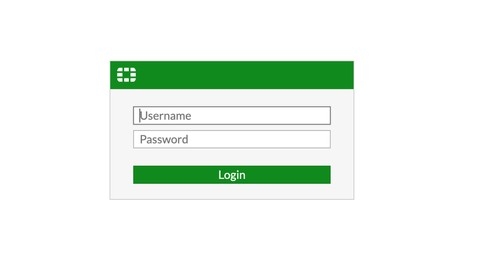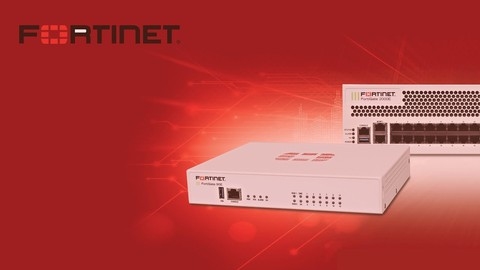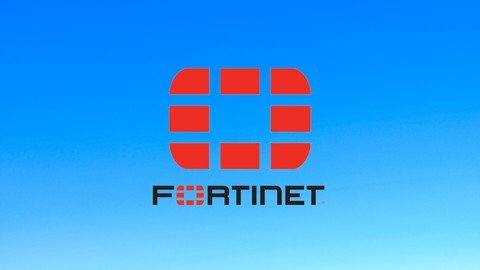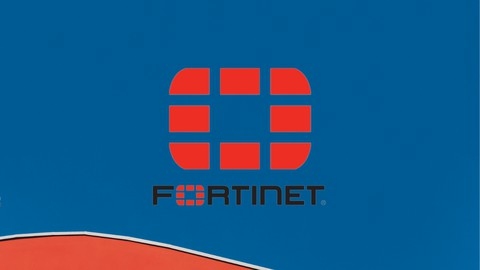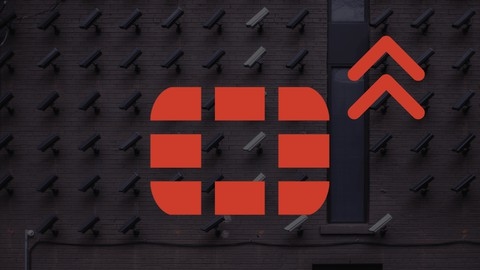If you’re looking for the best Fortigate courses on Udemy, you’ve clicked on the right link.
Fortigate is a popular firewall solution that provides robust security features for networks of all sizes.
In this blog post, we’ll explore the top Udemy courses that will equip you with the knowledge and expertise to excel in the field of Fortigate security.
Fortigate Firewall - Admin Crash Course
Best Udemy course for mastering FortiGate administration, networking, and security fundamentals.
This course starts with an introduction to administration, covering essential tasks like setting up your virtual machine, configuring admin profiles and trusted hosts, and backing up your configuration.
You’ll then dive into core system management, learning how to create user accounts through both the GUI and CLI, monitor system status, control feature visibility, and set up email alerts.
The course equips you with the skills to execute basic networking commands like pinging devices.
Moving on, you’ll explore the fundamentals of policies and network modes.
You’ll learn to create basic policies, understand the differences between NAT and transparent modes, and configure transparent mode features like MAC table entries, forwarded domains, and virtual wire pairs.
The course provides in-depth coverage of networking essentials like interfaces, zones, DHCP services (including DHCP options), VLANs, and virtual hardware switches.
You’ll master configuring ingress and egress rules for interfaces and creating VLAN policies.
Network Address Translation (NAT) is a crucial topic, with dedicated sections on IP pools, virtual IPs, and central NAT management.
The routing module covers static routes, routing attributes like distance and priority, and Equal-Cost Multi-Path (ECMP) routing.
Finally, you’ll learn to secure your network with VPNs, including SSL-VPN setup and configuration, as well as IPsec VPN implementation across multiple lessons.
Throughout the course, you’ll gain hands-on experience with the Fortigate CLI, making you proficient in both the GUI and command-line interface for managing your Fortigate Firewall.
FortiGate Firewall Version 6.4 NSE4 Training
Best Udemy course for learning FortiGate firewall configuration and security features with hands-on labs.
The course starts with an introduction to network security terms and malware identification, laying the foundation for understanding firewall technologies and the FortiGate platform.
You’ll learn how to install FortiGate firewalls on different virtualization platforms like VMWare, GNS3, and EVE-NG, making it easy to follow along with hands-on labs.
The course dives deep into the FortiGate dashboard, interfaces, zones, and administrative access, ensuring you understand the core functionality.
Routing is a crucial aspect, and you’ll configure static, default, policy, and dynamic routing protocols like RIP, OSPF, and BGP.
You’ll also learn about routing redistribution, a valuable skill for complex networks.
Firewall policies are covered extensively, including MAC address, local user, IP address, service, and schedule-based policies.
You’ll learn to configure DHCP servers and relays, a must-have skill for network administrators.
Security is a top priority, and the course covers FortiGate’s robust security features like antivirus, web filtering, DNS filtering, application control, intrusion prevention, and file filtering.
You’ll learn about inspection modes, NGFW modes, and how to block applications like Facebook using policy-based modes.
Network Address Translation (NAT) is essential, and you’ll configure various NAT types, including source NAT, destination NAT, and central secure NAT (SNAT).
You’ll also work with address and service objects, which are building blocks for policies.
High Availability (HA) is crucial for mission-critical networks, and you’ll learn to configure active-passive and active-active HA setups.
Authentication is another vital aspect, and you’ll integrate FortiGate with Active Directory (AD) for active and passive authentication.
The course covers virtual domains (VDOMs), cryptography concepts like symmetric and asymmetric encryption, Diffie-Hellman groups, and Internet Protocol Security (IPSec).
You’ll configure site-to-site IPSec VPNs using both route-based and policy-based approaches.
Backup, restore, revision control, and firmware upgrades are covered, ensuring you can maintain and update your FortiGate firewalls.
You’ll also learn to configure SNMP, syslog, and traffic shaping for monitoring and bandwidth management.
Remote access is essential, and you’ll configure SSL VPN web portals and IPSec VPN remote access solutions.
The course covers CLI basics, troubleshooting techniques, and packet sniffing, equipping you with essential skills for day-to-day operations.
Additionally, you’ll explore emerging technologies like Software-Defined Networking (SDN), keeping you ahead of the curve.
FortiGate Firewall NSE4 Version 7 Training Part1/2
Best Udemy course for mastering FortiGate firewalls with hands-on labs and NSE4 certification prep.
This course provides comprehensive training on the FortiGate firewall, covering both theoretical concepts and hands-on labs.
You’ll start by learning about network security fundamentals like confidentiality, integrity, and availability, as well as threats like malicious software.
The course then dives into different firewall technologies, including web application firewalls (WAFs) and next-generation firewalls (NGFWs) like FortiGate.
You’ll get an overview of Fortinet and prepare for the NSE4 certification exam.
A major focus is setting up a lab environment using EVE-NG and VMware Workstation, where you’ll upload FortiGate and other images to create a realistic network topology for practicing.
Administrative tasks are covered in-depth, such as using the FortiGate dashboard, monitoring interfaces, and configuring different deployment modes like VLAN, zones, one-armed sniffer, redundant interfaces, aggregate interfaces, software switches, and virtual wire pairs.
You’ll learn how to manage administrative access and set up DNS.
Routing is another key topic, including static, default, policy-based, and dynamic routing protocols like RIP, OSPF, BGP, and equal-cost multi-path (ECMP).
Hands-on labs ensure you can configure and verify each protocol.
The course explores DHCP, covering both the theory and configuring DHCP servers on FortiGate and Windows Server, as well as DHCP relay.
Network Address Translation (NAT) is essential, so you’ll learn about different NAT types like source NAT, destination NAT, overload, fixed port range, port block allocation, and virtual IPs.
Policy-based NAT configuration is practiced extensively.
You’ll dive into FortiGate’s security policies, including MAC address-based and local user-based policies.
Setting up Active Directory, DNS, users/groups, NTP and certificate authority on Windows Server is also covered.
Finally, the course teaches you to configure and verify critical security profiles like SSL inspection, antivirus, and web filtering on the FortiGate firewall.
Fortigate Firewall Administration Course
Best Udemy course for Fortigate training with hands-on lab setup and comprehensive coverage of administration, security, and networking.
The course starts with an introduction and lab setup using GNS3, ensuring you have a hands-on environment to practice.
You’ll dive into Fortigate administration, learning how to perform initial setup, manage admin users, configure secure access, recover passwords, backup and restore configurations, and upgrade firmware.
The course covers essential networking concepts like configuring interfaces, VLANs, inter-VLAN routing, redundant interfaces, and link aggregation.
NAT and transparent mode operations are explained in-depth, including how to enable NAT, configure IP pools, and set up destination NAT for port forwarding.
Routing is another key area, covering both static and dynamic routing protocols.
Security is a major focus, with modules dedicated to security profiles like antivirus, web filtering, DNS filtering, application control, intrusion prevention, and file filtering.
You’ll learn how to control traffic using policies and implement traffic shaping.
Authentication methods like local users, LDAP, and FSSO are covered to secure access.
The course also explores high availability setups like active/active HA clusters.
SD-WAN is an increasingly important topic, and you’ll learn how to configure SD-WAN, load balancing rules, and leverage its capabilities.
VPN technologies are thoroughly explained, including site-to-site IPsec VPN, remote access IPsec VPN, and SSL VPN configuration.
Throughout the course, you’ll work on practical labs to reinforce the concepts learned.
Introduction to Fortigate Firewall
Best Udemy course for learning FortiGate fundamentals and advanced configurations.
You’ll start with the fundamentals, learning about IP addresses and subnetting through interactive quizzes.
The course then dives into setting up Fortigate lab environments using various platforms like VMWare Workstation, GNS3 Network Emulation Software (KVM VM), Amazon AWS EC2, and EVE-NG (KVM VM).
You’ll also learn how to obtain permanent trial licenses for Fortigate 7.2.1 and later versions.
Once you have your lab set up, you’ll configure essential Fortigate features like Layer 3 interfaces, firewall policies, router-on-a-stick, static routes, and NAT types.
The course covers securing the Fortigate firewall through hardening techniques and creating GUI or SSL-VPN certificates using ACME and Let’s Encrypt.
You’ll learn to upgrade FortiOS software, backup and restore configurations, manage processes and services, and configure IPSec VPN for site-to-site connections.
Additionally, you’ll explore advanced topics like configuring logs, captive portals, high availability (HA) clusters, SSL portals for client VPN access, and virtual switches.
The troubleshooting section equips you with skills to diagnose and resolve issues with your Fortigate deployment.
Throughout the course, you’ll apply your knowledge through hands-on labs and quizzes, ensuring you gain practical experience.
Configuring Fortigate Unified Threat Management Appliances
Best Udemy course for learning FortiGate fundamentals, configuration, and advanced features.
The course starts with the basics, guiding you through the initial setup process, including USB management, console connection, resetting the admin password, and performing a factory reset.
You’ll also learn how to switch to interface mode and update the firmware.
Moving on, you’ll dive into the system settings, exploring the dashboard, status, network configuration, and admin settings.
The course provides PDFs to help you understand redundant connections and dual WAN scenarios, as well as changing the default DHCP lease time.
One of the key areas covered is policy and object configuration, along with security profiles and VPN setup.
You’ll have access to PDFs explaining the policy monitor, VPN monitor, and user monitor, ensuring you have a thorough understanding of these critical components.
The course also covers wireless functionality, with a dedicated section on the WiFi controller.
Additionally, you’ll learn about logging and reporting, with a detailed PDF on the FortiView option.
Practical exercises are a significant part of the course, allowing you to apply your knowledge in a simulated environment.
You’ll configure interfaces, addresses, policies, virtual IPs, web filtering, antivirus filtering, and application filtering.
The course also covers dial-in VPN setup and log analysis.
Beyond the core topics, the course delves into advanced features like device recovery tools, Fortinet WiFi access points, transparent mode, virtual domains (VDOMs), single sign-on, SSL VPN, site-to-site VPN, data leak prevention, email filtering, and intrusion prevention.
With the course update covering FortiOS 5.4, you’ll stay up-to-date with the latest Fortinet technologies.
FortiGate Firewall NSE4 Version 7 Training Part2/2
Best Udemy course for FortiGate security features configuration and hands-on learning.
The course starts with an introduction and provides lab environments and workbooks to facilitate hands-on learning.
You’ll dive into configuring essential security features like web filtering, DNS filtering, application control, intrusion prevention systems, and file filtering.
The course teaches you the theory behind these components before guiding you through practical configuration exercises.
For network protection, you’ll learn about DoS policies and how to configure IPv4 DoS protection.
Authentication is another key area covered, including active directory integration and setting up FSSO for seamless user authentication.
A significant portion focuses on virtual private networks (VPNs).
You’ll explore cryptography fundamentals like symmetric/asymmetric encryption, hashing algorithms, and Diffie-Hellman groups.
Then, you’ll configure various VPN types: site-to-site (template-based, custom, and policy-based), as well as remote access VPNs using SSL, IPsec, and the web portal mode.
The course also covers advanced topics like SD-WAN implementation and virtual domains (VDOMs) for multi-tenant environments.
High availability configurations, including active-passive and active-active modes, ensure network resilience.
Troubleshooting skills are essential, so you’ll learn packet capturing, sniffing techniques, CLI commands, and methodologies for effective troubleshooting.
Finally, the course guides you through backup/restore processes and firmware upgrades.
Fortinet NSE4_FGT-7.2 & FortiGate FCP_FGT_AD-7.4 - NEW Prep
Best Udemy course for FortiGate certification preparation, covering setup, configuration, and security features.
This course prepares you for the Fortinet NSE4_FGT-7.2 and the new FCP_FGT_AD-7.4 certification exams.
You will learn to configure and administer FortiGate devices running FortiOS 7.2 and 7.4.1, covering essential topics like deployment, system configuration, firewall policies, authentication methods, content inspection, routing, VPNs, and more.
The course starts by teaching you how to perform initial FortiGate setup and implement the Fortinet Security Fabric.
You’ll learn to configure log settings, VDOMs (virtual domains), and high availability clusters.
Diagnosing resource and connectivity issues is also covered.
Next, you’ll dive into firewall policies, NAT (Network Address Translation), and various authentication methods like FSSO (Fortinet Single Sign-On).
Inspecting encrypted traffic using certificates is explained, along with configuring web filtering, application control, antivirus scanning, and IPS (Intrusion Prevention System) to secure your network.
Routing is a key focus area, with lessons on static routing, policy-based routing, and SD-WAN (Software-Defined Wide Area Network) for load balancing WAN links.
You’ll learn to set up SSL VPNs for secure remote access and configure meshed or partially redundant IPsec VPNs.
ZTNA (Zero Trust Network Access) for role-based application access is also covered.
The course includes four practice tests to assess your readiness for the NSE4_FGT-7.2 and FCP_FGT_AD-7.4 exams.
Passing these exams leads to certifications like Fortinet Certified Professional - Network Security, Public Cloud Security, and Security Operations, validating your expertise in securing networks and applications using Fortinet products.
Advanced Fortigate Configuration
Best Udemy course for mastering FortiGate automation, security features & integrations with Terraform.
This course goes from automation with Terraform to advanced security features like DDoS protection and IPS.
You’ll start by learning how to automate Fortigate deployments on AWS and GCP using Terraform.
This is a valuable skill for efficiently managing infrastructure at scale.
The course then dives into advanced configuration topics like SD-WAN, dynamic routing with OSPF, policy-based routing, and setting up a bastion host.
One of the highlights is the extensive coverage of integration with various services.
You’ll learn how to integrate Fortigate with LDAP for user authentication, including SSO and OpenLDAP.
The course also covers syslog integration with FortiAnalyzer, Splunk Enterprise, and network monitoring tools like PRTG and SolarWinds NPM.
Security is a major focus, with modules dedicated to DDoS protection, intrusion prevention, blocking IP/domain lists using Threatfeeds, and configuring web filtering and transparent proxy.
You’ll also learn traffic shaping, virtual domains (VDOMs), and IPv6 dual-stack configuration.
The course doesn’t just cover theory – it includes hands-on walkthroughs for tasks like installing Fortigate VMs on GCP, applying licenses, resetting admin passwords, and restoring configuration backups.
You’ll even learn advanced scripting techniques for Fortigate.
Fortigate Firewall - UTM Crash Course
Best Udemy course for learning FortiGate security features like Anti-Virus, CDR, and IPS.
The course starts with an introduction and setting up your machine, ensuring you have the right environment to follow along.
You’ll dive into essential security features like Anti-Virus, learning about its database and the different inspection modes like flow and proxy.
The course covers grayware, heuristics, and leveraging Fortiguard Encyclopedia for enhanced protection.
It also teaches you how to handle large files, decompress them for scanning, and configure timeout overrides.
The course provides in-depth coverage of Content Disarm and Reconstruction (CDR) in two dedicated sections, ensuring you understand this critical security mechanism.
You’ll also learn about integrating external virus hash databases for enhanced malware detection.
Web filtering is a crucial aspect, and the course covers it comprehensively, from understanding how it works to category overrides, site authentication, flow mode actions, and blocking specific files.
You’ll master techniques like log search phrases, usage quotas, URL filtering (simple, wildcard, and regular expressions), and safe search enforcement.
Application control is another key area, with sections on blocking specific applications like TeamViewer, application overrides, filter overrides, logging FTP events, handling session-aware applications like Netflix, and enforcing protocols like QUIC.
The course dives deep into Intrusion Prevention System (IPS), explaining how it works, default templates, signature types, and deep SSL inspection.
You’ll learn to protect against botnets, create customized signatures, and understand denial of service policies.
Throughout the course, you’ll gain insights into log analysis and security event monitoring, ensuring you can effectively manage and troubleshoot your Fortigate firewall.
